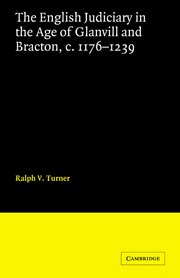Book contents
- Frontmatter
- Contents
- Acknowledgements
- Abbreviations
- 1 THE REPUTATION OF THE ROYAL JUSTICES
- 2 GLANVILL AND HIS COLLEAGUES, c. 1176–89
- 3 THE ORIGINS OF A PROFESSIONAL JUDICIARY IN THE REIGN OF RICHARD I
- 4 KING JOHN'S CORPS OF JUSTICES
- 5 PATTISHALL, RALEIGH AND THEIR COLLEAGUES
- 6 THE WORK OF THE JUSTICES
- Conclusion: The judges and their critics
- Appendix: Royal justices, c. 1176–1239
- Manuscript sources
- Index
- CAMBRIDGE STUDIES IN ENGLISH LEGAL HISTORY
Conclusion: The judges and their critics
Published online by Cambridge University Press: 07 October 2011
- Frontmatter
- Contents
- Acknowledgements
- Abbreviations
- 1 THE REPUTATION OF THE ROYAL JUSTICES
- 2 GLANVILL AND HIS COLLEAGUES, c. 1176–89
- 3 THE ORIGINS OF A PROFESSIONAL JUDICIARY IN THE REIGN OF RICHARD I
- 4 KING JOHN'S CORPS OF JUSTICES
- 5 PATTISHALL, RALEIGH AND THEIR COLLEAGUES
- 6 THE WORK OF THE JUSTICES
- Conclusion: The judges and their critics
- Appendix: Royal justices, c. 1176–1239
- Manuscript sources
- Index
- CAMBRIDGE STUDIES IN ENGLISH LEGAL HISTORY
Summary
A survey of forty-nine justices from late Henry II to Henry III's personal rule shows change from a group of largely unspecialized royal servants to a professional corps. Mainly responsible for Henry II's curia regis were the justiciar, the treasurer, and three bishops, aided by an inner core of eight knights and clerks; this group of justices also consituted a large bloc of the barons of the Exchequer. Only two men among Henry II's justices – Godfrey de Lucy and Robert of Wheatfield – seem to have concentrated on the work of the courts. After Hubert Walter became justiciar by 1194, we still see a number of high-ranking curiales playing an active role in justice at Westminster, but we can also identify a group of eight lesser-ranking justices who were giving most of their attention to the courts. Most noteworthy were two, Richard of Herriard and Simon of Pattishall, both of whom remained prominent justices after Geoffrey fitz Peter succeeded to the justiciarship. Hubert Walter, who was responsible for so many administrative reforms, also deserves credit for setting up a judicial bench separate from the Exchequer board.
By the time of King John, the process of professionalization and specialization is easier to see. Only four of seventeen justices were familiares regis, men-of-all-work close to the king. The rest were rather obscure men, clearly concentrating on the work of justice.
- Type
- Chapter
- Information
- Publisher: Cambridge University PressPrint publication year: 1985



